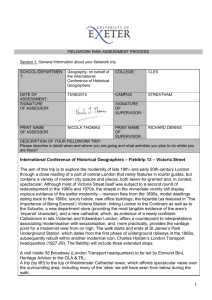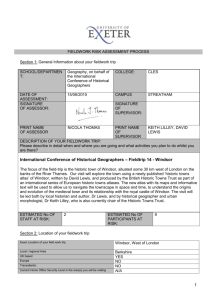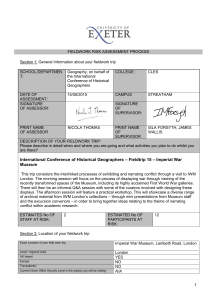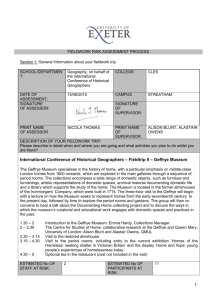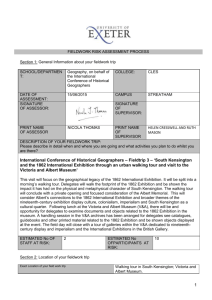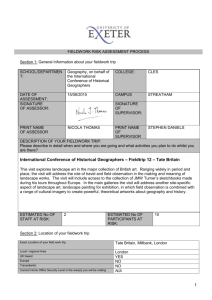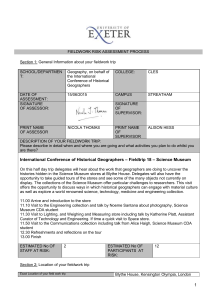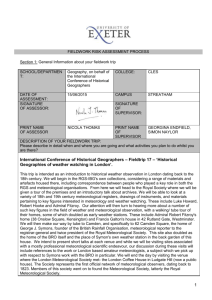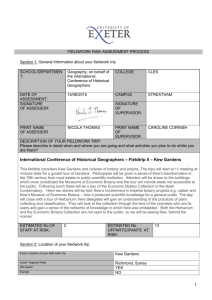ICHG_Fieldwork_Risk_assessment 6 – Finsbury and the City
advertisement
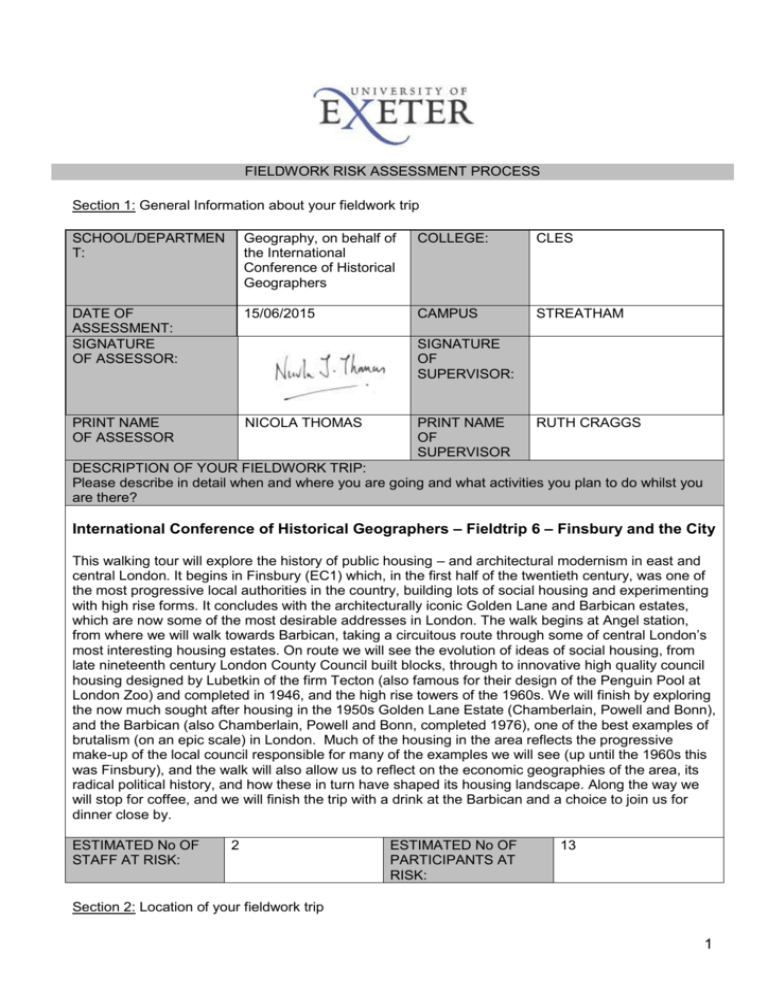
FIELDWORK RISK ASSESSMENT PROCESS Section 1: General Information about your fieldwork trip SCHOOL/DEPARTMEN T: Geography, on behalf of the International Conference of Historical Geographers COLLEGE: CLES DATE OF ASSESSMENT: SIGNATURE OF ASSESSOR: 15/06/2015 CAMPUS STREATHAM PRINT NAME OF ASSESSOR NICOLA THOMAS SIGNATURE OF SUPERVISOR: PRINT NAME OF SUPERVISOR RUTH CRAGGS DESCRIPTION OF YOUR FIELDWORK TRIP: Please describe in detail when and where you are going and what activities you plan to do whilst you are there? International Conference of Historical Geographers – Fieldtrip 6 – Finsbury and the City This walking tour will explore the history of public housing – and architectural modernism in east and central London. It begins in Finsbury (EC1) which, in the first half of the twentieth century, was one of the most progressive local authorities in the country, building lots of social housing and experimenting with high rise forms. It concludes with the architecturally iconic Golden Lane and Barbican estates, which are now some of the most desirable addresses in London. The walk begins at Angel station, from where we will walk towards Barbican, taking a circuitous route through some of central London’s most interesting housing estates. On route we will see the evolution of ideas of social housing, from late nineteenth century London County Council built blocks, through to innovative high quality council housing designed by Lubetkin of the firm Tecton (also famous for their design of the Penguin Pool at London Zoo) and completed in 1946, and the high rise towers of the 1960s. We will finish by exploring the now much sought after housing in the 1950s Golden Lane Estate (Chamberlain, Powell and Bonn), and the Barbican (also Chamberlain, Powell and Bonn, completed 1976), one of the best examples of brutalism (on an epic scale) in London. Much of the housing in the area reflects the progressive make-up of the local council responsible for many of the examples we will see (up until the 1960s this was Finsbury), and the walk will also allow us to reflect on the economic geographies of the area, its radical political history, and how these in turn have shaped its housing landscape. Along the way we will stop for coffee, and we will finish the trip with a drink at the Barbican and a choice to join us for dinner close by. ESTIMATED No OF STAFF AT RISK: 2 ESTIMATED No OF PARTICIPANTS AT RISK: 13 Section 2: Location of your fieldwork trip 1 Exact Location of your field work trip Finsbury, the Barbican, central London housing estates walking tour Local / regional Area East and Central London YES NO NO N/A UK based Europe Transatlantic Current Home Office Security Level in the area(s) you will be visiting Section 3: the Hazards involved in the work you are planning Highlight the relevant hazards in the list below Climate: Based in UK urban areas with potential exposure to sun, wind and rain. Temperatures could fall between 13 and 28 degrees depending on weather conditions. Terrain/Location: Fieldtrip will be in urban location with sustained traffic on nearby streets. There may be uneven pavements and steps. Biological: NONE Chemical: NONE Mechanical: NONE Electrical: NONE Human Activity: Participants will be in together in a group. This can mean that individuals cease paying attention to their own safety. Recreation: NONE Work Procedures: Participants will be travelling as a group. We will be in an urban location so a possible hazard could be assault or theft. People may have less awareness of their position and step into the road or slip off pavements. There is a risk of injury in relation to trips and falls and accidents involving cars. Work Abroad: n/a Other Stressors: General: Pre-existing conditions, Food intolerance/allergy Behaviour: Participants are adults from different countries. There may be unanticipated differences or misunderstandings. Legal problems: NA Security: NA 2 Section 4 – Your assessment of the risks (Risk Assessment) 1 Hazard number What is the hazard (e.g. low temperature, falling rocks) 1. (C) Consequenc e (1-5) X 3 X 5 X (L) Likelihood (1-5) = (RS) Risk Score (1-25) Action to be taken to control the risk (please list all actions you will be taking) Residual Risk (the remaining risk once your controls are put in place) C X L = RS 2 = 5 1 x 1 = 1 1 = 5 Participants asked to carry water and weather protection clothing (including sunscreen, hats and wet weather gear). Field leaders to carry sunscreen Field leaders to remind participants to carry water and apply sun cream at the start of the trip if they are outside for significant time. Participants warned about the risk; participants reminded to use pavements and pedestrian crossing points. Participants informed about length of walking tour and advised to wear comfortable shoes. 1 X 1 = 1 1 X 1 = 1 Climate: sun rain, wind exposure 2. Terrain/Location: Fieldtrip will be in urban location with sustained traffic on nearby streets. There maybe uneven pavements and steps. Walking tour will last approximately 3 hours. 3. Field leader to identify emergency exit codes in any buildings visited and to alter participants to these. 5 Human activity: Participants will be in together in a group. This can mean that individuals cease paying attention to their own safety. Specific aspects requiring attention include disembarking from transport and crossing roads. X 1 = 5 Participants alerted to risk. Field leaders to alert participants of potential risks and direct them clearly to safe routes. 3 4. 5. 6. Work Procedures: lack of awareness, slipping in an unfamiliar urban environment. Lacking attention to traffic. General: Pre-existing conditions, Food intolerance/allergy, Foot problems, Lack of fitness, exhaustion. Behaviour: Participants are adults from different countries. There may be unanticipated differences or misunderstandings. 5 X 1 = 5 Participants warned about the risk; participants reminded to use pavements and pedestrian crossing points; 1 X 1 = 1 1 X 1 = 1 1 X 1 = 1 1 X 1 = 1 Participants asked to disclose pre-existing medical /dietary conditions which may cause risk . Participants have been asked to indicate dietary requirements so allergic reactions are unlikely to be a problem. Field leaders will be reminded to call emergency services should any need arise, This is unlikely to cause difficulties as participants share a common bond. Field leader to be aware of group dynamics and to diffuse any tensions. 1 X 1 = 1 4 5
